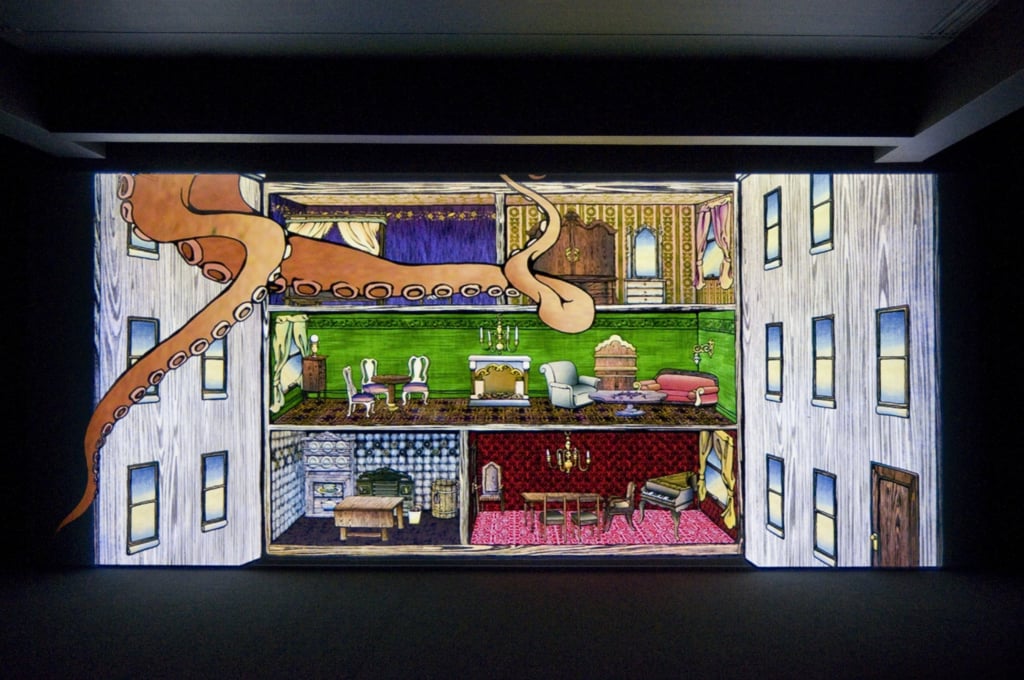Hands, Octopuses, and a Dolls’ House
In the video 'Dolefullhouse', artist Tabaimo illustrates how Japanese society has lost its bearings by drawing on its symbols.

Tabaimo, “DolefullHouse” © James Cohan Gallery
Animated tales somewhere between the comical and the grotesque, against a backdrop of a tragic reality: this is how Tabaimo’s dark films are constructed.
The artist, whose real name is Ayako Tabata, was born in 1975 and lives and works in Nagano. She first trained in Japanese painting at the University of Art and Design in Kyoto before moving to London and working for illustrator Jonathan Barnbrook’s agency. Since returning to Japan in 2005, she has dedicated herself fully to her artistic practice. She achieved international recognition in 2011 when she represented Japan at the Venice Biennale with her video installation teleco-soup.
Between video art, animated film, and drawing, Tabaimo combines multiples references. The artist’s universe brings together the cultural codes regularly linked to Japan and depicts the evils specific to its contemporary society. The artist uses dark humour to present a critique of a harsh society that’s losing its bearings.
Surrealism as a tool for reflection
In DolefullHouse (2007, 6:21), the artist presents a dolls’ house and a bourgeois universe that evolves over time, in a surrealist atmosphere. The video begins with the ‘opening’ of the façade of the house by human hands, letting out the water that was contained inside. The hands then move inside the house, putting the interior in order, adding furniture and decoration. As the minutes pass, the hands start to scratch each other frantically, and octopuses—highly symbolic animals in Japanese culture—try to enter the house. The gestures become more sudden and the hands end up going inside the house, weakening the structure. When the façade closes, the viewer can see human organs in the water. The artist’s message might seem confused, as the action can be interpreted in various ways. However, Tabaimo refuses to reveal its meaning, allowing the public to form their own opinion.
The originality of the piece lies in an unusual articulation of symbols in Japanese culture (here, an octopus), ordinary places and environments, and the technique of animation that is extremely popular in Japan.
In another register of her body of work, the series of drawings entitled flow-wer depicts flowers springing out of human organs. Her work has found its way into the collections at leading institutions such as the Cartier Foundation for Contemporary Art (Paris), the Japan Foundation (Tokyo), and the Museum of Contemporary Art (Los Angeles).
DolefullHouse (2007), is a video created by Tabaimo, an artist represented by the James Cohan Gallery.

Tabaimo, “DolefullHouse” © James Cohan Gallery
TRENDING
-
A House from the Taisho Era Reveals Its Secrets
While visiting an abandoned building, Hamish Campbell discovered photographs the owner had taken of the place in the 1920s.

-
The Taboo-Breaking Erotica of Toshio Saeki
The master of the 1970s Japanese avant-garde reimagined his most iconic artworks for a limited box set with silkscreen artist Fumie Taniyama.

-
With Meisa Fujishiro, Tokyo's Nudes Stand Tall
In the series 'Sketches of Tokyo', the photographer revisits the genre by bringing it face to face with the capital's architecture.

-
Masahisa Fukase's Family Portraits
In his series ‘Family’, the photographer compiles surprising photos in which he questions death, the inescapable.

-
Hajime Sorayama's Futuristic Eroticism
The illustrator is the pioneer for a form of hyperrealism that combines sensuality and technology and depicts sexualised robots.





